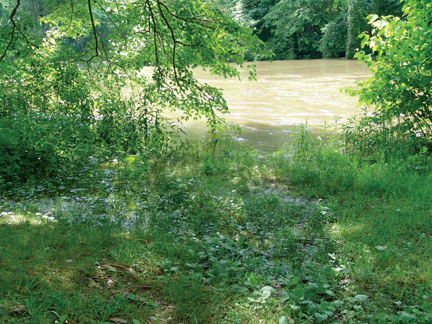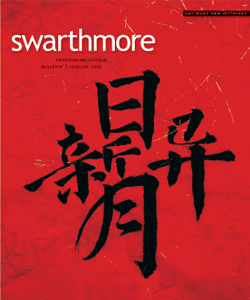Out of the Classroom and into the Woods—and Back
 How many of us know that when you touch the seeds of a jewelweed plant (also known as touch-me-not), they’ll explode with a “pouf!” under your fingers? Allison Jordan ’09 didn’t either, until she came upon the plant and its interesting property while walking in the Crum one day, doing research for an assignment in Professor of English Literature Elizabeth “Betsy” Bolton’s course Writing Nature.
How many of us know that when you touch the seeds of a jewelweed plant (also known as touch-me-not), they’ll explode with a “pouf!” under your fingers? Allison Jordan ’09 didn’t either, until she came upon the plant and its interesting property while walking in the Crum one day, doing research for an assignment in Professor of English Literature Elizabeth “Betsy” Bolton’s course Writing Nature.
Jordan, a four-year Garnet swimmer, says: “I’m really passionate about swimming, and when I saw the plant explode, it reminded me of swimmers diving off the starting block.” She went on to write a paper comparing the swimming strokes freestyle, backstroke, butterfly, and breaststroke with four parts of the plant.
“It was one of my favorite papers to write, because, in doing it, I actually got to share something I really care about with the other course participants,” Jordan says.
This semester, Bolton is teaching the popular course for the fourth time since 1998, when, as a member of the Environmental Studies (ES) Planning Committee, she first offered it in response to a need for more humanities-based courses in the ES program. It also helped fill a need in the English Department for “half-workshops,” where coursework is divided between literary analysis and creative writing. “I’d wanted to teach a pair of classes—an introductory course called Reading Nature—and then the half-workshop Writing Nature, but the reading course just never happened,” Bolton says.
So, using The Norton Book of Nature Writing by John Elder and Robert Finch, class members read and analyze literary samples demonstrating journal writing, nonfiction prose, poetry, and experimental fiction. “You can’t write if you don’t read,” Bolton says. “Those two things are always combined. If you want to write about Nature, you have to have a sense of the literary models as well as a sense of natural history—and, of course, you have to have some writing background,” Bolton says.
The students also hike in the Crum. Then, having collected impressions and observations from their field walks, they create their own versions of various nature-writing styles.
Bolton has appreciated the field assistance of Scott Arboretum staff, particularly Educational Coordinator Elizabeth Haegele, who has guided the students through the Crum Woods to see and reflect on Nature in action.
Haegele was delighted to assist in the course, profiting from the opportunity to engage with the students as well as with Bolton. “Working at the Arboretum, it’s easy to feel disconnected from the student body and the academic work, so when the chance arose for me to actively participate in a course and get to know the students and work with Betsy , I jumped on it,” she says.
“We split the Crum into different sections and introduced the students to new plants, animals, and concepts within each area. We taught them about wetlands in Skunk Cabbage Hollow and geologic history at Alligator Rock. Being part of this class has been one of the best things I’ve done since coming to Swarthmore,” Haegele says.
Filling in for Haegele one session, Horticultural Coordinator Jeff Jabco revealed to the students that the dividing line between the Piedmont plateau and the Atlantic Coastal Plain runs through campus, stretching in front of Parrish Hall and along past Wharton Hall. “The College is situated in a very interesting place, so there’s a lot of richness for the course,” Bolton says.
Because the course offers such diversity of content as well as being suitable for both English and Environmental Studies requirements, students choose it for a variety of reasons ranging from a desire to focus seriously on writing; to a love of the Crum and wish for “more in-depth Nature study than dissecting owl pellets in fourth grade”; to exploration of the ways people write about science and natural phenomena; to classmates’ recommendations of Bolton’s teaching style.
Jordan says: “I’d never been in a writing seminar before, and I’ve enjoyed that we edit each others’ work. I had fun on the hikes and getting to know people in my class. It’s really connected me to the College. It’s one of the best classes I’ve taken.”
—Carol Brévart-Demm
 Email This Page
Email This Page